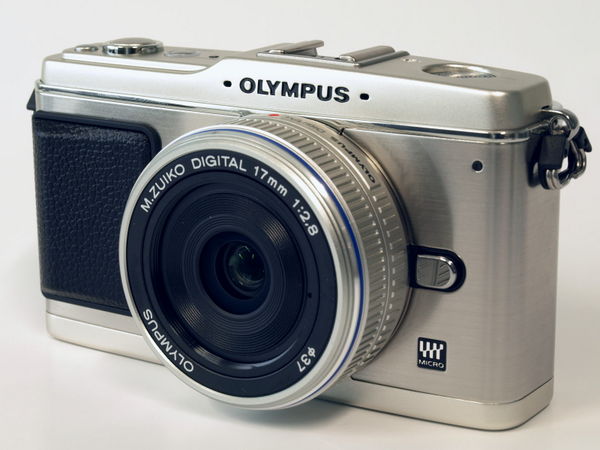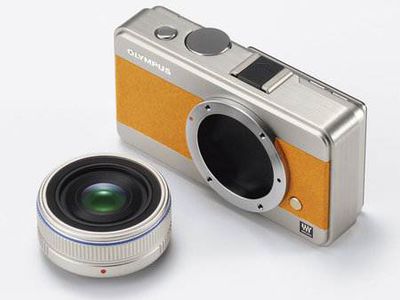Micro Four Thirds: Unterschied zwischen den Versionen
K (OM-5 eingefügt) |
K (Stand geändert) |
||
| Zeile 33: | Zeile 33: | ||
:''"For my work, I used 35mm, 645, 6x6, 6x9, 6x12, 4x5 and even some 8x10. My workhorse for construction and aerial work was 645 with Mamiyas, and I shot a lot of that, making prints up to 20x24 regularly. Four years ago I had occasion to replace some C prints that I had shot in the mid '90s on fine-grain C-41 process film with some new prints, as the old prints had faded noticeably. The new prints were inkjets and were all slightly larger than the former prints and were from files shot on 16-MP Olympus Micro 4/3 cameras as well as 21-MP Canon FF cameras. '''The Canon prints were slightly smoother than the Olympus prints, but both were definitely better technically in all respects than the Mamiya 645 prints they replaced.'''<br>"These were all medium contrast scenes; I'm not sure that very long range, high contrast shots would have shown such a decisive advantage without some extra heroics, but in the examples at hand there was no doubt."'' | :''"For my work, I used 35mm, 645, 6x6, 6x9, 6x12, 4x5 and even some 8x10. My workhorse for construction and aerial work was 645 with Mamiyas, and I shot a lot of that, making prints up to 20x24 regularly. Four years ago I had occasion to replace some C prints that I had shot in the mid '90s on fine-grain C-41 process film with some new prints, as the old prints had faded noticeably. The new prints were inkjets and were all slightly larger than the former prints and were from files shot on 16-MP Olympus Micro 4/3 cameras as well as 21-MP Canon FF cameras. '''The Canon prints were slightly smoother than the Olympus prints, but both were definitely better technically in all respects than the Mamiya 645 prints they replaced.'''<br>"These were all medium contrast scenes; I'm not sure that very long range, high contrast shots would have shown such a decisive advantage without some extra heroics, but in the examples at hand there was no doubt."'' | ||
| − | == Verfügbare [[Kamera]]s (Stand: | + | == Verfügbare [[Kamera]]s (Stand: Oktober [[:Kategorie:2022|2022]]) == |
Die Firmen [[Olympus]] und [[Panasonic]] bieten zurzeit folgende [[EVIL|EVIL-Kameras]] mit dem [[MFT]]-[[Bajonett]] an: | Die Firmen [[Olympus]] und [[Panasonic]] bieten zurzeit folgende [[EVIL|EVIL-Kameras]] mit dem [[MFT]]-[[Bajonett]] an: | ||
{| | {| | ||
Version vom 26. Oktober 2022, 12:57 Uhr

Beschreibung
Am 5. August 2008 verkündeten die FT-Partner Olympus und Panasonic die Einführung des Micro Four Thirds-Standards (auch als MICRO FourThirds, µFourThirds, µFT oder MFT bezeichnet bzw. abgekürzt) als konsequente Fortführung der Miniaturisierung des FT-Systems.
In Prospekten, Beschreibungen bzw. Händleranzeigen im Internet wird Micro Four Thirds bei Objektiven bzw. deren Anschluss (Bajonett) meist mit der letztgenannten Abkürzung für Micro Four Thirds als MFT-Anschluss bezeichnet.
Micro Four Thirds ersetzt keineswegs das Four Thirds System (FT), sondern ergänzt dieses für Kameras/Objektive mit besonders kompakten Ausmaßen. Da die Sensorgröße der der "großen" FT-Spiegelreflexkameras (DSLR) entspricht, bietet Micro Four Thirds - trotz kompakter Ausmaße - die gleich hohe Bildqualität wie die "großen" Kameras. Auch können wie bei den "großen" Wechselobjektive montiert werden.
Weiterhin besteht - durch das geringe Auflagemaß - die Möglichkeit, systemfremde Objektive zu adaptieren - siehe hierzu den getrennten Artikel: Adapter (Fremdobjektive auf µFT-System).
Als erste Kamera weltweit nach dem neuen Micro Four Thirds-Standard stellte Panasonic Ende 2008 die Panasonic LUMIX DMC-G1 vor. Mitte 2009 erschien dann die erste Micro Four Thirds-Kamera von Olympus: die Olympus PEN E-P1.
Als Sammelbegriff für diese Kameras hat sich mittlerweile der Begriff EVIL-Kameras eingebürgert.
Kuriosa
Es gab in der Vergangenheit auch Kontakte zwischen Nikon und dem mFT-Konsortium - hier ein Zitat aus dem Atikel von pen-and-tell.de dazu:
- "Vor der V1 (!) hat Nikon sehr lange mit dem mFT-Konsortium verhandelt und sich dann entschlossen, selber mit einem System rauszukommen. Das haben sie innerhalb von nicht mal einem Jahr entwickelt und mittlerweile unauffällig wieder eingestellt. Das V-System ist damit in unrühmlicher Gesellschaft mit den Samsungs und dem gelben Pentax-Ziegelstein. Auch das Pentax Q-System ist mittlerweile Geschichte."
Unterschiede zum FT-System
Aufbauend auf FT werden folgende Änderungen durchgeführt:
- Reduktion des Auflagemaßes von 38,85 mm auf 19,6 mm, was durch den Wegfall des Spiegelkastens erreicht wird.
- Reduktion des Bajonettaußendurchmessers von 60 mm auf ca. 54 mm. (+/- 0,3mm)
- Mittels des Olympus MMF-1 Adapters oder auch des Panasonic DMW-MA1 Adapters können die FT-Objektive an Micro Four Thirds-Bodys betrieben werden. Die in der Folge kleineren Micro FT-Objektive können allerdings nicht an FT-Bodys betrieben werden.
- Erhöhung der Kontaktanzahl zwischen Body und Objektiv von 9 Pins auf 11 Pins.
Hier finden Sie weitere Informationen zum Micro Four Thirds-Standard und den derzeitigen Partnern.
Einschätzungen der Bildqualität im Vergleich zur analogen Fotografie
Immer wieder werden Vergleiche der Bildqualität von (analogen) Film- und (digitalen) µFT-Systemen angestellt - hier eine sehr gute Einschätzung. Bitte beachten Sie, dass hier von "wirklichen Prints" (in sehr großen Größen) und nicht von der 1:1-Betrachtung am Monitor ("Pixelpeeper") gesprochen wird - machen Sie sich Ihr eigenes Bild (Quelle):
- "For my work, I used 35mm, 645, 6x6, 6x9, 6x12, 4x5 and even some 8x10. My workhorse for construction and aerial work was 645 with Mamiyas, and I shot a lot of that, making prints up to 20x24 regularly. Four years ago I had occasion to replace some C prints that I had shot in the mid '90s on fine-grain C-41 process film with some new prints, as the old prints had faded noticeably. The new prints were inkjets and were all slightly larger than the former prints and were from files shot on 16-MP Olympus Micro 4/3 cameras as well as 21-MP Canon FF cameras. The Canon prints were slightly smoother than the Olympus prints, but both were definitely better technically in all respects than the Mamiya 645 prints they replaced.
"These were all medium contrast scenes; I'm not sure that very long range, high contrast shots would have shown such a decisive advantage without some extra heroics, but in the examples at hand there was no doubt."
Verfügbare Kameras (Stand: Oktober 2022)
Die Firmen Olympus und Panasonic bieten zurzeit folgende EVIL-Kameras mit dem MFT-Bajonett an:
Interne Verweise
- Micro Four Thirds Objektive (Übersicht)
- Four Thirds Objektive (Übersicht)
- Olympus-OM-Objektive (Übersicht)
- Kategorie Objektive allgemein (Übersicht)
- Adapter (OM-Objektive auf FT- und µFT-System)
- Adapter (FT-Objektive auf µFT-System)
- Adapter (Fremdobjektive auf µFT-System)
- Adapter (Fremdobjektive auf FT-System)

